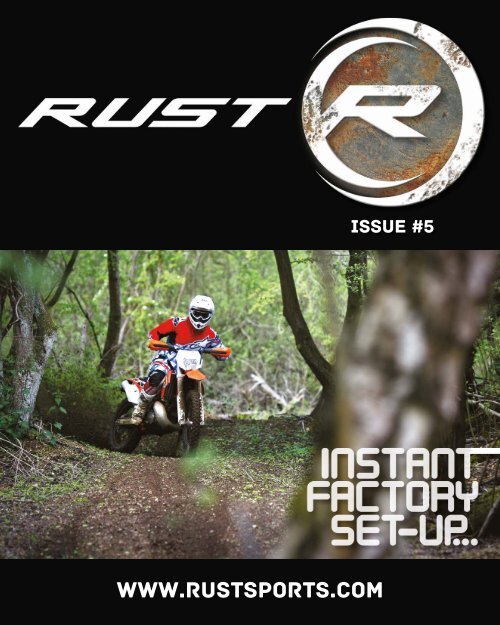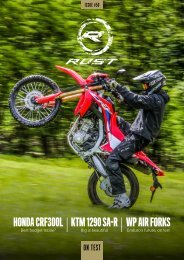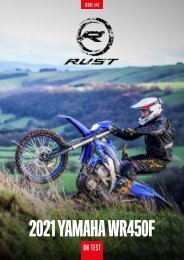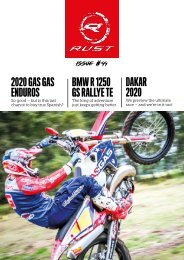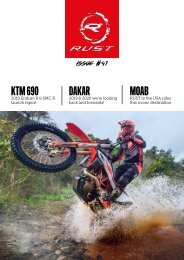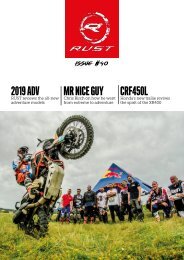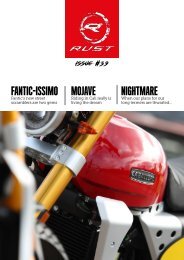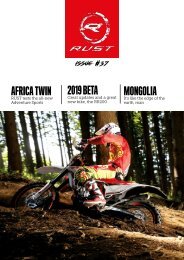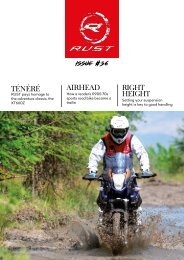RUST magazine: Rust#5
RUST magazine: Want to know how to set up your bike like a pro? Well in RUST #5 we give you the lowdown on the top tips that’ll make your bike handle and your confidence soar. And meet the guys transforming the Trail riders Fellowship from an old boys’ club, to a contemporary collective.
RUST magazine: Want to know how to set up your bike like a pro? Well in RUST #5 we give you the lowdown on the top tips that’ll make your bike handle and your confidence soar. And meet the guys transforming the Trail riders Fellowship from an old boys’ club, to a contemporary collective.
Create successful ePaper yourself
Turn your PDF publications into a flip-book with our unique Google optimized e-Paper software.
www.rustsports.com<br />
issue #5
Ed itorial<br />
lap<br />
two<br />
By SI MELBER,<br />
photo: Si Melber<br />
Hi there<br />
AND SO IT begins… Another year sat on the startline of this endurance race<br />
I call dirt bike journalism. A miss-spent youth promisingly developed into a<br />
miss-spent career - to paraphrase the late father of one of our columnists.<br />
So what keeps drawing me back year after year?<br />
Certainly not the money. Sure I’m properly rewarded for what I do, but friends<br />
I grew up with earn twice as much; they live in bigger houses, equipped with<br />
bigger garages packed to the rafters with sports stuff they never get time to<br />
use. Hey… I wanna’ have stuff I never get time to use. Oh and they get to ride<br />
sit-upon lawnmowers at the weekend whereas I don’t even own a windowbox.<br />
Okay so it must be the chance to test ride all the latest shiny dirt bikes? Well<br />
sure, that has obvious appeal to a petrolhead like me, but actually that’s not<br />
the reason either. New bikes are great of course, but the truth is that doing<br />
this job is a bit like being a valet car parker outside some gaudy Vegas hotel.<br />
You get to spend your time revving the rings off some of the fanciest metal<br />
known to man, but at the end of the day you always have to return it to its<br />
rightful owner - albeit slightly worse for wear. And actually, having ridden all<br />
the very latest tackle, I’m quite content to come home to the comfort of my<br />
own well-loved machinery.
“Rust NeverSleeps”<br />
Nope, the real reason I do this is because I haven’t quite finished the job<br />
that I set out to do. Twenty years ago I launched a <strong>magazine</strong> called TBM that<br />
aimed to shake up the off-road industry with the novel approach of telling the<br />
honest truth about dirt bikes. You know… warts and all, as opposed to simply<br />
regurgitating what the manufacturers wanted us to believe.<br />
That was a lot of fun. We worked for you guys (the consumers), exposed<br />
some bare-faced lies, took manufacturers to task, built some amazing friendships,<br />
built some god-awful project bikes, took part in a lot of races, finished<br />
a few of them, and generally enjoyed ourselves. So when the chance came<br />
to create the new <strong>RUST</strong> brand out of the box of bits marked ‘TBM’, naturally<br />
I grabbed it with both hands, lovingly assembled the parts, poured some fresh<br />
fuel in it and jumped aboard.<br />
I hope you like what we have created here at <strong>RUST</strong>. Because rather like<br />
brewing a really good craft beer, we like to take our time about producing<br />
a worthwhile product that’s carefully assembled from fine ingredients. And<br />
which offers more in the way of reward than the tasteless gassy fizz which<br />
characterizes much of the internet’s content. Sometimes that takes a little<br />
longer to make, but we think it’s worth the wait. That’s the <strong>RUST</strong> way of<br />
doing things. And I believe it’s the right way… Si Melber<br />
We want to hear from you. Contact editorial@rustsports.com with your feedback.
Ri ck Kemp<br />
gunning<br />
for<br />
trouble<br />
by rick kemp. photograph: web<br />
I’M GOING TO come clean and put my hands up… I’m a member of a gun<br />
club. No we’re not talking Uzis, and all that right-to-bear-arms stuff; this is<br />
still Great Britain after all and as things stand we’re not required to own a<br />
semi-automatic assault rifle just in case the zombie apocalypse comes to<br />
rural Kent. No, we’re talking about a bunch of ordinary gentlemen and<br />
women who enjoy country pursuits, and get together to shoot some sporting<br />
clays by way of working up an appetite for Sunday lunch.<br />
I had my first air rifle at the age of ten then worked my way through the<br />
shotgun calibers, 410, 20-bore and finally a 12-bore at about the age of<br />
14 - all hand-me-downs, naturally. Back in the day a shotgun certificate cost<br />
five bob’ from the Post Office. It was a bit like getting a dog license or a TV<br />
icense, there was no Spanish Inquisition about what you wanted to use it for<br />
and unlike today’s TV license, no national ad campaign threatening that if<br />
you’re caught without one you’re liable to spend five years in chokey with a<br />
bunch of failed jihadies.
As a young adolescent, being invited on a shoot was a right of passage;<br />
however at that age hormonal activity also dictated that girls should be in<br />
evidence at every possible occasion, and quite frankly there weren’t any -<br />
well except for your mate’s mum dispensing pies and port at lunchtime from<br />
the back of a Land Rover. My fascination with firearms dwindled over the<br />
years as urban living got in the way, but now in my dotage, I’ve gone full<br />
circle. What’s all this got to do with trail riding you may ask? Not much, but<br />
stick with it.<br />
The catalyst turned out to be a <strong>magazine</strong>. I was in my local countryside<br />
store - all waxed cotton and rat poison - when I spied a publication entitled<br />
Pull which I naturally assumed to be a dating mag, as you hear so much<br />
about lovelorn farmers going on wife-hunting trips to the Philippines. Anyway<br />
I flicked through from the back as one does, expecting to find Asian sirens<br />
draped over straw bales, but to my horror it was full of fat blokes with guns.<br />
At least they were clothed. The centrefold was one George Digweed… Did
Rick Kemp<br />
you know he has 23 shooting World Championships<br />
to his credit? Me neither, but as I discovered Pull is<br />
actually the official journal of the British Clay Pigeon<br />
Shooting Association.<br />
I had been thinking about getting a shotgun for some<br />
time. Not so much for blowing apart small furry things -<br />
fun though that may be - but something that might stop<br />
a Mitsubishi 4x4 pickup driving off with my 300 gallon<br />
heating oil tank on the back. Apparently, you’re not<br />
allowed to do that anymore the nice lady at the post<br />
office informed me. Though she did say it with a little<br />
wink. I wonder if that’s admissible in court?<br />
Anyway on the subject of oil, you know those people<br />
who still hanker after the smell of Castrol R so much<br />
that they put some in the petrol tank? Well I’d forgotten<br />
just how evocative the smell of Young’s 303 gun oil<br />
could be. One whiff of that stuff and suddenly I’m<br />
back in short trousers in the gun room at my parent’s<br />
house, trying to look manly and catch the eye of Susan<br />
Maplethorpe, the girl from next door who used to come<br />
over to help me walk the dogs. Now I think about it,<br />
maybe I should put some of that gun oil in the CCM’s<br />
tank. I mean it says it’s formulated to clean the inside<br />
of barrels. I digress.<br />
So what have guns got to do with trail riding? Well as<br />
they’re my two main recreational activities of choice,<br />
I’ve been attempting to bring them together recently.<br />
Rather like the biathlon at the Winter Olympics that<br />
combines skiing and shooting, why not trail riding<br />
and shooting? Obviously the rules would have to be<br />
different, you wouldn’t really want to have a highspeed<br />
getoff with a 12-bore strapped across your<br />
back. Anyway I’m lucky enough to have two shooting<br />
‘<br />
I ficked through t<br />
the back, as one<br />
find Asian sirens<br />
bales, but to my<br />
of fat bloke<br />
grounds within striking dist<br />
being accessible by a love<br />
So I figured, that if I coul<br />
six-hour off-road route tha<br />
shooting venues including<br />
of an excellent day out. Ro<br />
not too arduous, all that no<br />
some way of transporting m<br />
bangers to the shooting gr<br />
unsure as to the legal situa<br />
firearm on a motorcycle.<br />
Unfortunately I couldn’t f<br />
to help out, as the law insi<br />
license for a gun in order t<br />
options dwindling I chucke<br />
over one shoulder and a c<br />
fired up the CCM and took<br />
Not being entirely sure re<br />
of riding whilst armed, I fel
he <strong>magazine</strong> from<br />
does, expecting to<br />
draped over straw<br />
horror it was full<br />
s with guns.<br />
’<br />
ance with the nearest one<br />
ly Byway through the forest.<br />
d come up with a gentle<br />
t took in one or other of the<br />
lunch, I’d have the makings<br />
ute planning proved to be<br />
w remained was to find<br />
y gun plus a bag full of<br />
ound as I was slightly<br />
tion of carrying around a<br />
ind anyone able (or willing)<br />
sts you need to have a<br />
o transport it. So with<br />
d the shotgun in a slip case<br />
artridge bag over the other,<br />
to the backroads.<br />
garding the legal position<br />
t it my civic duty to proceed<br />
with undue haste along the blacktop. Reason being<br />
that my shotgun certificate states that with “a shotgun<br />
in transit, reasonable precautions must be taken for<br />
the safe custody of the gun”. My risk assessment<br />
concluded that travelling at a reasonable clip on the<br />
least congested roads would constitute “reasonable<br />
precautions”.<br />
I hadn’t gone far when I noticed I’d somehow<br />
attracted the attention of a dark-coloured Land Rover<br />
which appeared to be gaining ground on me on the<br />
country roads No bother, turning onto the forest track,<br />
which at this time of year is closed to 4WD vehicles,<br />
I figured that that was the end of it. So imagine my<br />
surprise when - whilst executing a sublime rear-wheel<br />
steer around a quickish bend on this forestry track - I<br />
caught sight of the same dark-coloured Land Rover<br />
which now appeared to be hot on my tail.<br />
I twisted the CCM’s throttle harder, as I still had over<br />
a mile of track to cover and I had no intention of letting<br />
this would be boy-racer overtake me and cover me in<br />
mud. But the harder I rode the faster he went…<br />
Still I managed to get to the end of the trail ahead of<br />
him and turned onto the tarmac... That was when the<br />
siren came on, accompanied by a flash of blue light in<br />
my mirrors. Oh!<br />
“What seems to be the problem officer? I enquired<br />
of the chap in a black baseball hat and matching<br />
Police Armed Response Unit overalls who was<br />
crouching down pointing a handgun at me. “You are.”<br />
He replied. Things kind of went downhill from there.<br />
It turns out that the term “reasonable precautions”<br />
is not a subjective construct…<br />
Rick Kemp
Back Issues<br />
www.rustsports.com<br />
www.youtube.com/watch?v=54lfOS3nMtE<br />
www.youtube.com/watch?v=mVYqp3biTnc<br />
www.youtube.com/watch?v=6XEkJabHLi4<br />
www.youtube.com/watch?v=QrOoVPEKi_E<br />
www.youtube.com/watch?v=gvyUxbymuMU<br />
www.youtube.com/watch?v=HQBn2qbfopY<br />
www.youtube.com/watch?v=HX4-14sIoHE<br />
www.youtube.com/watch?v=_L8ePyI2E4M<br />
www.youtube.com/watch?v=yriJw_FU910<br />
www.youtube.com/watch?v=8l54XQOYoPo www.youtube.com/watch?v=ooPAurYxQzY www.youtube.com/watch?v=9oHMTpB0RNw<br />
www.youtube.com/watch?v=mLpIT6Z-ACQ<br />
www.youtube.com/watch?v=ntK07I63tuA<br />
www.youtube.com/watch?v=x_co4hGeECA<br />
Visit www.rustsports.com for the latest video content,<br />
social media feeds and issues...<br />
To view any of these videos just click on the link below the<br />
thumbnail to go direct to the Rust Sports youtube channel...
issue #1 africa twin special<br />
issue #2 husqvarna 701 special yamaha wr450F special<br />
issue #3 issue #4 issue #5 issue #6 issue #7<br />
gs trophy special<br />
Issue #8<br />
issue #8 issue #9<br />
Subscribe for free at www.rustsports.com<br />
and we’ll e-mail you when a new issue comes out...<br />
All material appearing in <strong>RUST</strong> is copyright to Rust Sports Ltd and may not be reproduced<br />
in part or full (including electronically) without the express permission of the publishers.
Enduro<br />
Words & images: Jon Bentman<br />
Proper bike set-up will transform your ride. You don’t nee<br />
Just apply a little time and patience and work through a s<br />
the most amazing improvements. Honestly, the difference
FOR THE AMATEUR RIDER!<br />
d any fancy parts and very little technical knowledge.<br />
imple schedule of adjustments and you can create<br />
can be mind-blowing...
Enduro<br />
IF YOU’VE NEVER done this before, then<br />
you absolutely must try this, it can transform<br />
your riding experience. In just one day and<br />
with no money down (or maybe just a little),<br />
you can transform your bike into what is<br />
probably 85% of what a full-factory bike is.<br />
It’s so simple it’s ridiculous, and once you’ve<br />
done it you’ll kick yourself that you’ve never<br />
done it before.<br />
To show you how simple this process is,<br />
Rust has done it ourselves. We took a bog<br />
standard 2015 KTM 250EXC and a very<br />
docile Vet rider (6’0”/1.82m, 14st/89kg) to a<br />
standard issue enduro test track and within<br />
five hours we had the bike completely dialed,<br />
with a set-up (and options) that would last<br />
the season - in fact for as long as the rider<br />
hypothetically kept the bike.<br />
So here’s our step-by-step guide to<br />
factory-standard bike set-up (for dummies).<br />
STAGE ONE:<br />
FIT THE BIKE TO YOU<br />
First mission, very simply, is to adjus<br />
it, if you go into a bicycle shop, wha<br />
to suit riders of all heights and weigh<br />
with bigger frames. Serious shops e<br />
match. You go into a dirt bike shop a<br />
of dirt bike, but the frame size isn’t t<br />
we’re doing here is properly adjustin
t the bike to fit your own physique. Think about<br />
t do you see? Frames and wheels of all sizes,<br />
ts. The logic is basic: taller people buy bikes<br />
ven physically measure a rider up for an exact<br />
nd sure there are all different engine capacities<br />
ailorable and is virtually identical on all. So what<br />
g the bike to best match you.
Enduro<br />
1 SET THE SAG<br />
We need to start with setting the sag on the shock, which<br />
seems a curious place to start, but you’ll soon see why.<br />
And this you should do before you go out to ride - do it in<br />
the workshop.<br />
Now know this - when an owner’s manual tells you to<br />
check the sag with the rider in full kit you MUST do this.<br />
Our test monkey (ape!) is 89kg in his day clothes, but in<br />
full enduro kit (that’s helmet, goggles, boots and gloves<br />
included) he’s a whopping 97kg, that’s 8kg more, a gain of<br />
10%. So kit up first or your suspension set-up won’t be accurate.
Also, don’t take it for granted that if you set<br />
the sag last month that it’s still correct today.<br />
This bike had just come back from a professional<br />
bike test, yet when we checked the<br />
settings it had a static sag of 41mm (KTM’s<br />
recommendation is 33-35mm). Put 97-kilos<br />
of rider in the saddle and rider sag measured<br />
126mm, when target is 105-115mm.<br />
That’s way out.<br />
For data collection purposes we test rode<br />
the bike in that state first and have to say it<br />
felt just fine. Without any comparison to work<br />
from, I was revelling in the liveliness and<br />
sure-footedness of the lithe 250cc stroker.<br />
It’s a joy to ride, I could have carried on all<br />
day blissfully unaware I could have a ride<br />
experience that would be so much better.<br />
Finding the sag was wrong we upped the<br />
preload on the shock to put the sag back<br />
within the right parameters. Winding on the
Enduro<br />
69N/mm, but this is for a 75-85kg rid<br />
97kg rider we need a recommended<br />
spring. Cost from KTM is a modest,<br />
If you’ve got the tools you can fit this<br />
but if not, any bike shop should be a<br />
this in no more than 15 minutes. Wit<br />
still located in the frame it takes bare<br />
more - so simple is PDS. With the co<br />
weight now fitted we measured agai<br />
static sag of 34mm we got a rider sa<br />
- smack bang centre in the range.<br />
preload is a doddle and inside of 30-seconds<br />
we’d re-established 34mm of static sag.<br />
However with our test dummy back in the<br />
saddle (me) we now had a rider sag figure<br />
of 119mm. That’s outside of the recommendation<br />
by just 4mm. Worth worrying about?<br />
Honestly, what’s 4mm? So we test rode the<br />
bike again and frankly could barely tell the<br />
difference - and I was still more than happy.<br />
2 CHANGE THE SHOCK SPRING<br />
So, we have established that with a heavierthan-standard<br />
rider - despite having the<br />
correct static sag - we can’t get within the<br />
correct range for rider sag. What we need to<br />
do is fit a ‘heavier’ spring. Fortunately KTM<br />
have this situation covered. Check out the<br />
owner’s manual and you’ll find a table of<br />
riders’ weights and the correct shock spring<br />
to match that weight.<br />
The standard spring in the 250EXC is
er. For our<br />
72N/mm<br />
£80.<br />
at home<br />
ble to do<br />
h the shock<br />
ly 5-minutes<br />
rrect spring<br />
n and with a<br />
g of 110mm
Enduro<br />
Test riding this, the difference was a night-and-day improvement. The rear of<br />
the bike felt like it was riding two-inches higher. And with the rear now sat up<br />
higher there was less distance for the rider to transition from standing to seated.<br />
Plus the bike turned better, and landing off jumps it didn’t crash through its stroke<br />
so much. Accelerating there was less squat because with the correct spring rate<br />
the shock was operating in the correct part of the stroke for all occasions and this<br />
dramatically improved the performance. We’d spent £80, but it felt like we’d fitted<br />
a £1000 unit!
3 CHANGE THE FORK SPRINGS<br />
Now we don’t take sag measurements<br />
on the forks, even though it’s possible.<br />
But fortunately the KTM manual gives us<br />
recommendations for rider weights and<br />
again for a heavier rider you do need to fit<br />
heavier springs, this time we were upsizing<br />
from 4.2N/mm to 4.4Nm/mm springs. And<br />
for a pair of springs we’re again talking<br />
modest money, around £80 - plus fitting.<br />
Testing this it was immediately apparent<br />
that we’d rebalanced the bike. The shock<br />
spring alone had made a vast improvement<br />
and while I liked the way the bike turned so<br />
sharply as a result (the back riding higher,<br />
the front lower), overall having a matched<br />
set-up in the forks meant the bike was now<br />
better balanced in all aspects - maybe not<br />
turning quite so sharply, but with the upside<br />
of doing everything else better. The bike felt<br />
taller and bouncing over jumps and tracking<br />
through acceleration and braking bumps<br />
everything felt so much more composed - it<br />
was massively confidence inspiring.
Enduro<br />
4 SET THE HANDLEBARS<br />
The 250EXC has two mounting positions for<br />
the handlebar clamps, and the clamps can<br />
be rotated too to offer four possible positions<br />
with 22mm of front-to-back adjustment.<br />
Here, to match our 6’0” rider we went for<br />
the forward bolting position, with the clamps<br />
rotated to give max-forward too. And what<br />
an improvement that was. For barely an<br />
inch gain there was so much more feeling of<br />
space with an added bonus I could now get<br />
further forward when cornering, improving<br />
the grip of the front tyre in the turns. There’ll<br />
be other knock-on benefits too, like less<br />
AFTER<br />
BEFORE<br />
likelihood of arm pump or back strai<br />
more natural stance.<br />
And we went one step further, add<br />
adding about 10-15mm to the bar he<br />
riding a long rally, or say the Welsh T<br />
adopt this set-up, but for short-cours<br />
For short course racing the improve<br />
front end with the lower bar mount o<br />
you’d gain from a more comfortable<br />
with the higher clamps.
OUR GUIDE<br />
Gareth Edmunds, KTM UK<br />
n as you can adopt a far<br />
ing KTM’s higher clamps,<br />
ight. Now if we were<br />
wo Day we’d definitely<br />
e enduro - probably not.<br />
d connection with the<br />
utweighs any advantage<br />
standing attack position<br />
Gareth is a top technician. He’s spent years working<br />
on bikes at world championship level; first with<br />
motocrosser Tommy Searle and then with enduro<br />
racer David Knight (winning a world championship<br />
together). After that he spent years prepping top race<br />
cars in the world of GT, rally and endurance racing.<br />
These days he’s working with KTM UK, keeping their<br />
test fleet tip-top.<br />
“Riders really shouldn’t be afraid of making adjustments<br />
to their bikes, and they should understand that<br />
they make a real difference. One size does not fit all!<br />
“Work through the processes set out here, it’s<br />
exactly the way I’ve worked with the likes of Tommy<br />
and David. Take your time, make one adjustment at a<br />
time so you can evaluate the change, take notes, and
Enduro<br />
KTM’s optional hig<br />
seat is also slightly<br />
5 NEW SEAT?<br />
We’ve long been fans of the adjustable seats found<br />
on adventure bikes like BMW’s R1200GS as they can<br />
really make a difference for taller riders. Unfortunately<br />
motocross and enduro bike seats aren’t generally<br />
adjustable, so its been a case of making do.<br />
Now, to be fair, having set the correct suspension spring<br />
weights the feedback was that the seat already felt higher<br />
- because the rear wasn’t sagging under my weight so<br />
much. But having KTM’s next highest seat<br />
option ready to try - and if you look at the images you’ll
her<br />
flatter<br />
“Riders really shouldn’t be afraid<br />
of making adjustments to their<br />
bikes, and they should understand<br />
that they make a real difference.<br />
One size does not fit all!”<br />
if you ever get lost with what you’re doing you<br />
can always revert back to the standard settings.<br />
“When it comes to fine tuning the suspension, try<br />
and think logically. For instance, if you’re going to be<br />
riding a sandy enduro - say the Natterjack - think<br />
about what will work. Sand bumps - whoops - are<br />
typically long and even but you can be travelling<br />
quite fast. So I’d look to pull the forks through the<br />
clamps, to just one line showing, and add a little<br />
preload (half to one turn) to keep them high in the<br />
stroke. With the shock I’d typically look for a little<br />
more low-speed compression damping - just two<br />
or three clicks can make a big difference. If it roughs<br />
up, I’d then firm up the high speed compression by<br />
a quarter or half turn. Rebound damping I’d slow by<br />
two or three clicks. For the sag - set this at the top<br />
end of the scale (35mm static / 115mm rider).<br />
“But for a tight Welsh forest enduro you need to go<br />
the other way, drop the forks back to the standard<br />
setting and on the shock set the sag at the lower end<br />
of the scale (33mm static / 105mm rider) which will<br />
raise the rear so the bike turns quicker, especially in<br />
tight woods and grassy tests. When there are lots of<br />
roots, soften the damping and speed up the rebound<br />
to absorb the short-sharp shocks. It’s a matter of<br />
applying simple logic - and testing the results.”
Enduro
see it doesn’t look much higher, if anything just flatter<br />
- we weren’t going to skip on the opportunity.<br />
And what a difference it makes! I was bowled over.<br />
The transition from seated to standing was now so<br />
much easier. This is a massive gain for it means the<br />
rider is spending much less energy on raising and<br />
lowering his torso for each corner. And being a flatter<br />
seat its actually helping them put their weight in the<br />
right place.<br />
Being tall and heavy, when riding with the standard<br />
seat and standard suspension the back of the bike<br />
was riding low and the curve of the seat meant my<br />
bum was also inching backwards, making keeping<br />
weight over the front a real chore - and creating extra<br />
stress on the forearms (so inducing arm pump). The<br />
higher seat is instead ‘right there’ and it’s naturally<br />
keeping the rider in the right place: close to the front<br />
of the bike. I had to recalibrate the distance my leg<br />
had to extend to reach the ground in slow or bermed<br />
corners - a few times it just seemed to be dangling -<br />
but that’s easy to do.
Enduro<br />
6 THAT’S IT<br />
And so you should now be properly fitted to the bike. With the correct springs<br />
in the suspension it now operates exactly as the designers intended. It’s not<br />
running low with the suspension continually in the wrong part of its stroke.<br />
The rider also now has a comfortable cockpit to stand and sit in and with<br />
that space and the correct distances between your hands, feet and bum you<br />
won’t tire anywhere near as quickly as would be the case with the one-sizefits-all<br />
layout of the stock bike. Dynamically you’re now able to operate the<br />
bike exactly as intended, no compromises.
STAGE TWO: OPTIMISING<br />
THE BIKE TO THE TERRAIN<br />
Having got the bike to match the rider, we<br />
can now look at matching the two of them<br />
to the conditions. Of course terrain and<br />
conditions change venue-to-venue, so<br />
we’re looking at how to manage the bike’s<br />
adjusters to make the best match each<br />
time, just as the pros do. And again, with the<br />
help of the owner’s manual, we can do this<br />
far more easily than you might have thought.<br />
1 THE POWER VALVE<br />
We’re talking two-strokes here, but that’s<br />
quite a chunk of any paddock. The 250EXC<br />
we have here comes with three options on<br />
the spring that controls the speed that the<br />
power valve opens.<br />
‘Standard’ is a yellow-painted spring for<br />
‘medium tuning’ and good rideability. You<br />
can alternatively opt for a green-painted<br />
spring for softer performance (a firmer spring<br />
holds back the rate of opening of the power-
Enduro<br />
valve) or a red spring for more aggressive<br />
performance. Changing the spring takes about three<br />
minutes. Just lay the bike on its side, remove the two<br />
bolts that hold the cover over the springs, remove<br />
the spring set and swap to the spring of choice, then<br />
re-assemble. Easy!<br />
First we changed from standard to the red<br />
(aggressive) spring and yes, the performance was<br />
noticeably more peaky, the engine feeling that much<br />
more willing to rev, like a keen over-sized 125! It was<br />
actually - on our test track - really agreeable, it made<br />
going faster that much easier and for riding the likes<br />
of deep sand you’d pick this set-up each time.
Placing the green spring in we found a<br />
much mellower power delivery as you might<br />
want for riding in tight technical going, like<br />
thick forest or extreme. To ride fast it took<br />
a lot more effort, needing a bit of clutch<br />
slipping to urge the revs up quicker.<br />
The springs make a huge difference then<br />
and are well worth having in your spares<br />
box, ready to make that on-the-day adjustment<br />
to suit that wet, snotty enduro (green)<br />
or blisteringly dry deep-sand cross-country<br />
(red). Standard is just right for probably 75%<br />
of occasions.
Enduro<br />
2 ECU MAPS<br />
We had fitted to the test bike the optional<br />
handlebar switch that allows you to swap<br />
between the standard and a soft map that<br />
is pre-programmed into the stock ECU.<br />
It’s another very useful device and when<br />
we combined the soft map with the green<br />
spring this made for a super-mellow ride.<br />
As a racer you’d want this switch, it will<br />
make a difference. In fact it was an education<br />
just how far you could vary the engine<br />
characteristics, from super-snappy to<br />
super-torquey given a simple play with the<br />
springs and maps.
Enduro<br />
3 SUSPENSION SETTINGS<br />
Let’s all just admit to this: the physics of compression<br />
and rebound adjustments confuse us all. Even world<br />
class racers can easily get flummoxed, that’s why<br />
they have suspension specialists working full-time in<br />
the top teams. KTM know this, and to their credit in<br />
their manuals they offer three homegrown recommendations<br />
to achieve ‘comfort’, ‘standard’ and ‘sport’<br />
set-ups. Now these aren’t based on guesswork, these<br />
are settings they’ve put a lot of work into deriving and<br />
so, honestly, they have to be the go-to solution for<br />
95% of us amateur riders. But using them - well<br />
do they make a difference? Let’s find out.
To start with, swapping the compression and<br />
rebound settings from standard to sport - handon-heart<br />
- it wasn’t that easy to determine any<br />
real difference. There’s a reason for this. You<br />
see, having tested a fair few works bikes over<br />
the years, we’ve found that what works for the<br />
world’s fastest riders often works just as well for<br />
us regular guys too. There is in effect quite a narrow<br />
range in which suspension works optimally,<br />
whether at high speed or moderate speed - and<br />
so the difference between the standard and sport<br />
settings really isn’t so great.<br />
However,stepping down to the ‘comfort’ setting
Enduro<br />
we found a massive difference. And around<br />
our test course this felt plain awful! The bike<br />
flattening itself off the jumps, riding low in<br />
the suspension stroke - honestly, there was<br />
nothing we could like. We think KTM should<br />
rename this their ‘extreme’ setting for if this<br />
was to work well anywhere we’d say it was<br />
for riding a seriously technical wet forest<br />
with lots of roots and rocks, and even then<br />
only if the speed was slow.<br />
So it’s definitely worth working with these<br />
settings to see how well they match your<br />
riding style and local terrain. You may well<br />
come up with your own intermediate<br />
settings, but having these fixed points as<br />
a starter you can at least venture forwards<br />
from solid points of reference.
Enduro<br />
CONCLUSION<br />
Our test so very<br />
the time to follow<br />
set-up. After litera<br />
bikes with suspe<br />
cockpit that didn’<br />
to just how much<br />
bike given just a<br />
This is, in fact,<br />
through when the<br />
rocket surgery. O<br />
A-kit suspension<br />
pep up their engi<br />
making a good b<br />
here. Do this and<br />
and for your ridin<br />
this before, try it<br />
4 JETTING<br />
Your importer/dealer should have set the jetting to the correct<br />
settings for your locality, but you can check this by referencing<br />
the matrix of carb settings KTM have in the owner’s manual.<br />
The over-riding logic that applies here is to set the jet sizes<br />
according to altitude and then either change the needle, or the<br />
position of the clip on the needle, according to the temperature.<br />
Jetting has been the traditional route to performance tuning,<br />
and if you wanted a zingy lively racer you would jet lean, for<br />
a blubbery trialsy-type performance you’d go rich. But given<br />
the developments in power valve and CDI technology we can<br />
argue quite persuasively that this no longer applies. It’s better<br />
these days to jet to KTM’s recommendations for altitude and<br />
atmospherics then use the map and powervalve springs to<br />
arrive at the desired engine characteristics.
: HELL YEAH, IT WORKS!<br />
clearly shows the benefits in taking<br />
these few very simple steps to<br />
lly years - decades - of riding<br />
nsion that was too light, with a<br />
t fit, it was a revelation to me as<br />
better you could make a standard<br />
few basic adjustments.<br />
exactly the process the pros go<br />
y get a new bike, and it really isn’t<br />
kay, at the end of the day they’ll fit<br />
and they’ll get some trick stuff to<br />
nes, but 85%, maybe more, of<br />
ike great is exactly as spelled out<br />
you’ll find new love for your bike<br />
g. As we said, if you’ve never tried<br />
now. Happiness awaits...<br />
The ‘basic’ Rust set-up...<br />
Suspension: 97kg rider meant heavier<br />
springs required<br />
Standard fork springs: 4.2N/mm,<br />
we needed 4.4N/mm<br />
Standard shock spring: 69N/mm,<br />
we needed 72N/mm<br />
Standard damping setting:<br />
Worked best for mixed terrain of woods<br />
and open field test<br />
Forks:<br />
Preload: 2 turns<br />
Compression: 20 clicks, rebound 18 clicks<br />
Shock:<br />
Low-speed compression: 20 clicks<br />
High speed compression: 1.5 turns<br />
Rebound: 24 clicks<br />
Rear shock:<br />
Static sag: 34mm<br />
Rider sag: 110mm<br />
Handlebars: Forward mounting position,<br />
clamp rotated to forward bias to suit 1.82m<br />
tall rider<br />
Seat: KTM Powerparts High Seat (+20mm,<br />
for riders over 1.80m, part no. 77207940400)<br />
Powervalve: Standard spring (yellow)<br />
ECU mapping: KTM Powerpart<br />
(handlebar-mounted) ignition curve switch<br />
(part no. 51539974100) set to standard (1)<br />
Jetting: Standard, pilot 38, main 175,<br />
needle N27H, clip position 3<br />
Tyres: OEM Maxxis 80/100-21, 140/80-18<br />
set at 13psi
Back Issues<br />
www.rustsports.com<br />
www.youtube.com/watch?v=54lfOS3nMtE<br />
www.youtube.com/watch?v=mVYqp3biTnc<br />
www.youtube.com/watch?v=6XEkJabHLi4<br />
www.youtube.com/watch?v=QrOoVPEKi_E<br />
www.youtube.com/watch?v=gvyUxbymuMU<br />
www.youtube.com/watch?v=HQBn2qbfopY<br />
www.youtube.com/watch?v=HX4-14sIoHE<br />
www.youtube.com/watch?v=_L8ePyI2E4M<br />
www.youtube.com/watch?v=yriJw_FU910<br />
www.youtube.com/watch?v=8l54XQOYoPo www.youtube.com/watch?v=ooPAurYxQzY www.youtube.com/watch?v=9oHMTpB0RNw<br />
www.youtube.com/watch?v=mLpIT6Z-ACQ<br />
www.youtube.com/watch?v=ntK07I63tuA<br />
www.youtube.com/watch?v=x_co4hGeECA<br />
Visit www.rustsports.com for the latest video content,<br />
social media feeds and issues...<br />
To view any of these videos just click on the link below the<br />
thumbnail to go direct to the Rust Sports youtube channel...
issue #1 africa twin special<br />
issue #2 husqvarna 701 special yamaha wr450F special<br />
issue #3 issue #4 issue #5 issue #6 issue #7<br />
gs trophy special<br />
Issue #8<br />
issue #8 issue #9<br />
Subscribe for free at www.rustsports.com<br />
and we’ll e-mail you when a new issue comes out...<br />
All material appearing in <strong>RUST</strong> is copyright to Rust Sports Ltd and may not be reproduced<br />
in part or full (including electronically) without the express permission of the publishers.
Ma<br />
TRF Feature<br />
Words: Jon Bentman Images: Jon Bentman, TRF & TBM Archives and various
You’ll not see it on the news, but<br />
a war is being fought in the British<br />
countryside right now. A war over<br />
the continued use of legal tracks<br />
and trails known as Green Roads.<br />
And following recent legislation,<br />
there’s sense that the final conflict<br />
could be about to play out…<br />
TRF<br />
WAR!<br />
rio Costa-Sa<br />
“Everyone is welcome - and we share everything,”<br />
explains Mario Costa-Sa, the Trail<br />
Riders Fellowship’s (TRF) Marketing and<br />
Membership Director. Costa-Sa delivers his<br />
message with the cautious deliberation of<br />
a campaigning politician, adding a sense of<br />
gravitas so that you are fully aware of how
T RF Feature<br />
important this is. It’s a mission statement alright…<br />
marketing types live by such rhetoric, but it’s an<br />
important matter. This simple statement sits at the<br />
forefront of the new cultural environment that the<br />
TRF has adopted. Welcome to the ‘new’ Trail Riders<br />
Fellowship…<br />
Final Act<br />
This is serious… The future of trail riding in the<br />
UK is at stake. A government law passed last year<br />
(The Deregulation Act) set in motion a new round of<br />
government-agency-level debates and reporting that
TRF<br />
WAR!<br />
could again threaten the future of legal trail<br />
riding. A working group is being set-up with<br />
the goal of once-and-for-all establishing the<br />
definitive facts about the use of un-metalled<br />
(green) roads in the UK. And once the<br />
reporting is finished, the government will<br />
decide what to do.<br />
So who will speak in our defence? The<br />
same team who always have done for the<br />
past 48 years: the TRF. That’s the Trail<br />
Riders Fellowship in case you’re not aware<br />
of their existence. Only I should make it<br />
clear that the TRF in 2016 is not the same<br />
TRF you might know from years past.<br />
No longer the quaint - almost reclusive -<br />
gentlemen’s club, settling into the corner of<br />
a country pub, covertly meeting up in their<br />
Barbour jackets and flat caps. No, there’s a<br />
new look… a new sense of confidence and<br />
self-determination. The TRF in 2016 is a
T RF Feature<br />
more assertive and proud organisation<br />
that’s positive about its contribution to the<br />
rural landscape and economy. No longer<br />
apologetic for its legal pastime, it seeks to<br />
be out and open about the pleasures of<br />
exploring rural Britain by motorcycle.<br />
“In the past, two major public criticisms of<br />
the TRF have been that they have not been<br />
very welcoming to people and that they have<br />
not shared the knowledge - of where the<br />
lanes are. Hopefully that is changing” says<br />
Mario with a grin.<br />
In fact much is changing within the TRF.<br />
The local groups are growing again, some<br />
rapidly. A reflection perhaps of their proactive<br />
stance on seeking new members, offering<br />
beginners’ rides to get newcomers initiated<br />
TRF<br />
WAR!
What are we talking about?<br />
DEFRA say there are 188,700km (116,994 miles)<br />
of public rights of way in the UK. The TRF reports<br />
that of these only approximately 6000 miles are<br />
currently classified as Byways Open to All Traffic<br />
(BOATs), Other Road with Public Access (ORPAs)<br />
or Unclassified County Roads (UCRs) and so remain<br />
open to motorised vehicles - that’s 5%. That’s<br />
not much, unfortunately there are pressure groups<br />
lobbying frantically for all these to be closed to cars<br />
and bikes too.<br />
in the ways of green roads. And emphasizing as much<br />
the social benefits of the TRF, as its long-understood<br />
and long-standing service in legal battles to save -<br />
‘conserve’ is the modern parlance - green roads for<br />
use by future generations.<br />
There are some new, younger faces coming up<br />
through the ranks, keen for change - not just for the<br />
sake of it, but to ensure that the TRF maintains its<br />
position, even increases its clout, in an ever-congested
T RF Feature<br />
island. The push for growth has been successful,<br />
some branches have doubled their membership inside<br />
a couple of years; last year alone the membership<br />
swelled nationally by 11%. After years of dwindling<br />
numbers, this is a welcome resurgence.<br />
“One of the issues,” continues Costa-Sa, “one of the<br />
fundamental issues with the TRF - that we are correcting<br />
- is the way the TRF was set up. There is a national<br />
organisation and then there are the groups. And all the<br />
funding from membership fees, went to the national
TRF<br />
WAR!<br />
organisation, to pay for rights of way cases.<br />
So the groups don’t [or didn’t] have their own<br />
funding, which meant the groups would simply<br />
go out and do their own stuff. There was<br />
no incentive for the groups to grow. So this<br />
stereotype of the TRF being cosy little insular<br />
groups - you can see how that developed.<br />
“With a bit more of a business head on,<br />
I’ve thought about how we could get the<br />
TRF to grow to the next level. And that’s<br />
required changing the model of how the<br />
TRF operates. It’s been a slow and painful<br />
process but we are getting there. There are<br />
still issues with its governance and structure,<br />
but we are working to resolve these.”<br />
Costa-Sa doesn’t use the phrase himself,<br />
but you get the feeling that what he’s trying<br />
to say is they’re making the organisation ‘fit<br />
for purpose’. As effective as they’ve been in
T RF Feature<br />
fighting to keep green roads open - chasing<br />
claims all the way to the Supreme Court if<br />
needs be - it’s now needing to establish a<br />
modern organisational footing if it is to<br />
remain financially and intellectually capable<br />
of defending trail riders’ rights in an increasingly<br />
litigious and costly future. And for that<br />
it needs numbers - bums on bike seats -<br />
generating the funds it needs to be effective.<br />
“The political and legal landscape is<br />
changing” adds Costa-Sa. Rights of way will<br />
become less important as we move along…<br />
More important will be areas of campaigning<br />
and political representation. Rather than<br />
worrying about individual ancient rights of<br />
way, the politics of countryside access will<br />
be the bigger issue. And this is arguably<br />
closer to a marketing issue than a legal one.<br />
“It’s about how you portray trail riding, how<br />
you portray the people who are doing it,<br />
even recognising trail riding as part of the<br />
TRF<br />
WAR!
Greg Villalobos<br />
wider economy, because money talks.”<br />
Arguably such change has been forced upon the<br />
TRF. Bitter experience has shown that all the factually<br />
correct data and reports in the world can be cast aside<br />
in a moment of strong political lobbying by the antis.<br />
This happened with the Natural Environment & Rural<br />
Communities (NERC) Act of 2006. Public consultation<br />
prior to the bill had given little reason for alarm. The<br />
government’s own report into the impact of motor
T RF Feature<br />
vehicles on the countryside had shown that activity<br />
was minimal and that there were no grounds to<br />
suppose significant issues were arising from vehicular<br />
usage. And so no need for legislative changes.<br />
But at the parliamentary hearing stage the anti-vehicle<br />
groups successfully lobbied several significant MPs<br />
to request amendments to the bill with the effect of<br />
killing off rights to any byway that had not already been<br />
recorded as a Byway Open to All Traffic (BOAT). And,<br />
equally damaging, to give extra powers to national park
TRF<br />
WAR!<br />
authorities to issue Traffic Regulation Orders<br />
(TROs - vehicle bans) on byways in the National<br />
Parks. As a consequence nearly all the<br />
byways designated as Roads Used as Public<br />
Paths (RUPPs), which had previously been<br />
legal to ride were downgraded to footpaths<br />
or bridleways. The amendments were an<br />
enormous blow to trail riding - in an instant<br />
wiping thousands of miles of green roads<br />
from the UK map.<br />
Craig Carey-Clinch of the Motorcycle Industry<br />
Association, was lobbying government<br />
at the time and begged for the amendments<br />
not to be adopted. He called for reason, “It is<br />
outrageous that Government and MPs have<br />
chosen to ignore common sense proposals<br />
regarding rural vehicle management, having<br />
instead been fooled into believing what is<br />
nothing short of misinformation and propa-
T RF Feature<br />
ganda.” But neither the government nor the Lords<br />
listened. It was a tough lesson to learn; facts and<br />
reason count for nothing when you have lobbyists<br />
applying political clout and frankly, hysteria.<br />
It is against this background that the new TRF has<br />
emerged. Politically sharper than before, and much<br />
more all-embracing. It seeks to make friends with its<br />
former adversaries and sit around the table with them.
TRF<br />
WAR!<br />
The 6 core values<br />
of the TRF<br />
CLARIFICATION CERTAINLY SEEMS<br />
high on the list of the TRFs new agenda.<br />
Knowing who the organisation is, and<br />
what it stands for, seems obvious but at<br />
the same time such clarity works both as<br />
a means to communicate and market the<br />
TRF’s values, making it less likely to be<br />
misconceived as a crazy bunch of motorcycle<br />
hoodlums and so better representing<br />
the mature decent people that actually<br />
make up the membership.<br />
“If you held up a mirror to the TRF you’d<br />
probably end up with a confusing diaspora<br />
that wouldn’t make any sense,” explains<br />
Mario Costa-Sa. “So, working with Greg<br />
Villalobos (a TRF member and communications<br />
and creative/brand specialist),<br />
we’ve devised a communication plan,
T RF Feature<br />
Where in the past certain militant elements within<br />
well-known walking groups had been the natural<br />
enemy of the trail rider, nowadays the emphasis is on<br />
a much more collaborative approach towards sharing<br />
the countryside with a whole host of other users.<br />
The walkers, for so long considered our most active<br />
opponents, would on contemporary evidence seem,<br />
at worst, to be ambivalent about vehicular use in the<br />
countryside. Now that so many byways have been<br />
closed, and now that the legal vehicular routes have<br />
been culled down to less than 5% of all rights of way,
TRF<br />
WAR!<br />
right from fundamentals, that’s looked<br />
for core values, namely six defining core<br />
benefits that explain just what the TRF is.<br />
“Contact: it’s about contacting thousands<br />
of members. Access: accessing<br />
routes that you would not find if you were<br />
not a TRF member. Improvement: improving<br />
your riding (if you were road riding<br />
you wouldn’t expect to crash, get up, crash<br />
again and think it’s the right way to learn,<br />
but in off-roading that seems perfectly acceptable!).<br />
Identification: identifying yourself<br />
(hence the logo stuff - it is important).<br />
Defence: defending yourself. When it all<br />
goes wrong - and as legal as we are, even<br />
I got pulled two days ago out on a trail<br />
ride, by the police - then being able to<br />
defend yourself and talk with confidence<br />
with the authorities is important. Out there<br />
on the trail it’s not if you get stopped, you<br />
will get stopped. And Sustainability, that<br />
means working with the likes of Tread<br />
Lightly, making sure that we keep access<br />
to the lanes and that we keep them in as<br />
good condition as we can.<br />
“Those are the six core benefits,<br />
which then move forward into our work<br />
in segmenting the market, looking at the<br />
positioning of TRF and having the brand<br />
as part of this. It has been a complicated<br />
process we’ve been through, Greg has<br />
been instrumental in this but there are a<br />
lot of people involved, it’s not just one<br />
man’s work.”
T RF Feature<br />
conflict between riders/drivers and walkers<br />
is very rare indeed. Encounters are so few<br />
that it’s become inconceivable that recreational<br />
walkers could have any justification<br />
or motivation to continue to persecute<br />
vehicle users. Take a look at the Ramblers<br />
Association website and you’ll not see any<br />
mention of efforts to ban vehicles from byways<br />
- it simply does not appear on their<br />
(public) agenda.<br />
Costa-Sa confirms this: “I’m a walker<br />
myself as well as a rider - I think many of<br />
our members are. And I am a Ramblers<br />
Association member, and I have to say I<br />
have not seen anything anti-trail riding in<br />
any of their correspondence or publications.<br />
So this imagined conflict I don’t know if that<br />
isn’t just a relic from the past. But certainly<br />
over the last couple of years when I’ve been<br />
TRF<br />
WAR!
very sensitive to the trail bike side of things, I haven’t<br />
seen anything anti from their side.” However over in the<br />
National Parks the situation appears to be worsening<br />
rather than improving…<br />
Boyd Emmerich is the proverbial foot-soldier on the<br />
front line in the National Parks. A former commercial<br />
pilot, today he operates a small trail riding business<br />
in the beautiful Peak District in Derbyshire. But over<br />
recent years he has seen the network of green roads<br />
in his locality (accessible by trail bike) repeatedly<br />
reduced - seriously damaging his business.
T RF Feature<br />
Anti-vehicle lobbyists are currently pushing hardest<br />
in his locality, persistently lobbying the National Park<br />
Authority to ban all vehicles from the park - thereby<br />
creating a national precedent. The park association<br />
has reacted to this by using NERC-enabled Traffic<br />
Regulation Orders (TROs) to close four of the area’s<br />
most significant green roads. Emmerich says that his<br />
annual turnover has fallen by 40% and he says other<br />
businesses are suffering too.<br />
“I’m trying to run a business,” says Emmerich. “But the<br />
amount of work needed in dealing with these closures is
Who’s Who in RoW?<br />
Acronyms abound in the world of green<br />
roads. So who’s pro-trail riding and who’s<br />
against? Here are some of the key players:<br />
For…<br />
TRF<br />
The Trail Riders Fellowship. Established<br />
in 1968, been fighting to keep green roads<br />
open ever since. About 4-5000 individual<br />
members plus affiliation with the vastly<br />
bigger ACU and BMF.<br />
LARA<br />
Land Access & Recreation Association.<br />
Formed in 1986, represents a multitude<br />
of motoring and motorcycling organisations<br />
(including the ACU and BMF) in a ‘wide<br />
range of land issues’ including representations<br />
to government and respective agencies.<br />
Something of a specialist legal unit, it<br />
acts in motorsport matters as well as green<br />
road issues.<br />
TRF<br />
WAR!<br />
GLASS<br />
Green Lane Association. Founded in 1995,<br />
it’s the TRF for the four-wheel crew, ‘dedicated<br />
to driving, protecting and researching<br />
our unique heritage of unsurfaced highways.’<br />
MCIA<br />
The Motorcycle Industry Association.<br />
Founded in 1910 it represents the motorcycle<br />
industry (manufacturers, importers, retail-
T RF Feature<br />
incredible, it simply never ends. It’s exhausting. As local<br />
businesses we should expect to be working in parallel<br />
with the authority to improve the living standards of all<br />
concerned, but that’s not happening.”<br />
Emmerich joined forces with local businessman (and<br />
trail rider) Andrew Richardson to create an association<br />
of local businesses in order to get their objections<br />
heard. He argues that the push for the silent utopian<br />
idyll - as frequently described by the antis - is killing<br />
local businesses, and in any case it can never exist.<br />
It’s not helping that the park authority - which should
ers) in the UK, including representation<br />
and contribution to projects and groups<br />
within government and its agencies.<br />
APTR<br />
Association of Peak District Trail Riders.<br />
Newly formed, representing 47 businesses<br />
and around 850 individuals in the Peak District<br />
who are all set to suffer if the round of<br />
green road closures in the Peak District National<br />
Park continue. Have been invited to<br />
join DEFRA’s Stakeholder Working Group<br />
alongside the TRF.<br />
Against...<br />
GLEAM<br />
Green Lanes Environmental Action Movement.<br />
‘The pressure group, founded in 1995,<br />
which campaigns for changes in the law to<br />
stop thoughtless off-road drivers damaging<br />
or destroying green lanes, and the rights of<br />
walkers, riders, pedal cyclists, carriage drivers<br />
and the disabled to use them without<br />
danger, difficulty and inconvenience.’<br />
TRF<br />
WAR!<br />
GLPG<br />
Green Lane Protection Group. Founded in<br />
2005, representing 21 organisations - ‘its objective<br />
was specifically to improve the NERC<br />
Bill and is now to work for its proper implementation.’<br />
Those 21: Allen Valleys Action<br />
Group (Northumberland), Battle for Bridleways<br />
Group (Herefordshire), Brecon Beacons<br />
Park Society, British Driving Society,<br />
Cambrian Mountains Society, Campaign to<br />
Protect Rural England, Campaign for the
T RF Feature<br />
remain impartial on the matter - have been publicly<br />
making statements that endorse the anti-vehicle<br />
agenda, even publishing links to the antis’ websites.<br />
Emmerich and the TRF have repeatedly highlighted<br />
the facts behind green road use. If you revisit some of<br />
the contentious closures by NPA’s they say, you’ll find<br />
that motorcycle usage is minimal: typically 4 or 5 riders<br />
a day (or less) on each of the roads. Even the Peak<br />
District National Park Authority’s own figures for Leys
Protection of Rural Wales, Campaign for<br />
National Parks, Country Land & Business<br />
Association, Cyclists Touring Club, Exmoor<br />
Society, Friends of the Lake District, Friends<br />
of The Ridgeway, GLEAM, Long Bostle<br />
Downland Preservation Society (West Sussex),<br />
North Wales Alliance to Influence the<br />
Management of Off-Roading (NWAIMOR),<br />
Peak District Green Lanes Alliance, Peak &<br />
Northern Footpaths Society, South Downs<br />
Society (Sussex), West Somerset and<br />
Exmoor Bridleways Association, Yorkshire<br />
Dales Green Lanes Alliance.<br />
TRF<br />
WAR!<br />
PDGLA<br />
The Peak District Green Lane Alliance.<br />
Set up in 2011 ‘to bring together everybody<br />
who wants green lanes in the Peak District<br />
to be closed to recreational off-roading’.<br />
Apparently ‘supported by’ the Ramblers<br />
Association, The Campaign to Protect Rural<br />
England, Friends of the Peak District, the<br />
British Horse Society, Peak Horsepower,<br />
Rocking the BOAT and, representing parish<br />
councils in the Peak District, the Forum for<br />
Ancient Byways. Yet curiously there seems<br />
to be only the one spokesperson, one Patricia<br />
Stubbs...<br />
Neutral<br />
DEFRA<br />
The Department for Environment, Food &<br />
Rural Affairs, in charge of public access to<br />
the countryside. Their opening statement on<br />
the matter: ‘Everybody should have the opportunity<br />
to access, use and enjoy England’s<br />
natural environment and outdoor spaces.’
T RF Feature<br />
TRF<br />
WAR!
Lane (one of the closures) reveal that motorcycle<br />
usage in 2014 averaged 1.9 bikes during weekdays<br />
and 5.3 bikes at weekends. So why the hysteria. Why<br />
the closures?<br />
Facts clearly have little to do with what’s going on.<br />
Emmerich says the recent actions in the Peak District<br />
and the announcement of a DEFRA-initiated working<br />
group on un-metalled roads all point to a ‘make or<br />
break’ for trail riding in the UK within the next two years.<br />
“We can no longer think and act like amateur organisations,”<br />
says Emmerich. “I think Mario (Costa-Sa)<br />
understands this and knows that this is a critical time.
T RF Feature<br />
We need to be professional and we need to make<br />
the economic point that we are thousands of people<br />
supporting a multi-million pound industry that’s pouring<br />
millions into the British economy. Kill green roads and<br />
you kill off hundreds, probably thousands of jobs. You<br />
kill businesses, not just in motorcycling but all those<br />
B&Bs, pubs, restaurants and local filling stations that<br />
support the recreational trail rider. The facts support<br />
the continued use of green roads - it’s sustainable -<br />
but that’s being ignored. I personally think it’s only<br />
the economic story that will save us now.”
TRF<br />
WAR!<br />
Alien Invader?<br />
Or friend of the countryside?<br />
The development of motocross and enduro<br />
riding gear has certainly changed the look<br />
of the average trail rider. Thirty or forty years<br />
ago we wore jeans and wax-cotton jackets,<br />
together with open-face helmets. Aside from<br />
the helmet, we looked much the same as<br />
any other person in the countryside. And<br />
of course the open face helmet meant we<br />
could be easily identified as a human and<br />
we could freely converse.<br />
Today we are inclined to dress up like<br />
Tony Cairoli ready for the latest round of the<br />
motocross world championship. And, while<br />
highly protective, that’s a look that could be
No Apologies<br />
And so the TRF has changed, you could call it evolved.<br />
But given the short time frame, the change in key<br />
personnel, the re-branding, the new communication<br />
strategy, the new website… well you could equally<br />
call it a revolution. It’s not been something that’s sat<br />
well with some members, the ‘commercialisation of the<br />
TRF’ as Emmerich describes it, but given the increas-
TRF<br />
WAR!<br />
construed as intimidating to some.<br />
Alan Kind sees this as highly counterproductive:<br />
“Put on your body armour and<br />
full-face helmet, and sit on your orange-andblack<br />
enduro rocket, in front of a mirror. Who<br />
do you see? Do you see someone who is<br />
equipped for quietly ‘exploring green lanes’<br />
(the TRF’s strapline, once upon a time), or<br />
someone who for most other citizens, has<br />
no legitimate place on our unmade ancient<br />
highways?<br />
“You decide, because it is your future and<br />
you can help to change it. You don’t give a<br />
monkey’s for what people think? Well then,<br />
enjoy it while you can.”<br />
There’s no question that the antis have<br />
hooked into the new competition-based look<br />
as a means to denigrate trail riders. If we<br />
look like competitors, hooligans or look the<br />
same as the illegal riders typically marauding<br />
around the countryside on stolen bikes,<br />
then how can the public determine who’s<br />
good and who’s bad?<br />
Should the ‘enduro rocket’ also be considered<br />
more carefully? Do you ride with competition<br />
numbers on the number boards?<br />
What does that suggest to the man in the<br />
street/lane/road? And do we need to be<br />
riding ‘enduro rockets’? After all, we are<br />
out to enjoy the countryside - this should be<br />
a tour, not a race.<br />
And if you want to ride fast, if you want to<br />
ride ‘challenging’ terrain then ask yourself,<br />
is the green road the place to do this?<br />
If you ride green roads consistently faster<br />
than 20-30mph then man-up and give rally<br />
or enduro a go!
T RF Feature<br />
TRF<br />
WAR!<br />
ing membership and sense of mobilisation you could<br />
argue it’s the right strategy at the right time. With<br />
Costa-Sa’s direction the TRF is now marketing itself,<br />
not just to new members, not just the industry, but to<br />
wider society, including the politicos. And in no uncertain<br />
style.<br />
Costa-Sa: “My rights of way officer here in Herts<br />
group, Steve Mann, a brilliant guy - and like me he’s<br />
new to the TRF - he nailed it when he said the TRF’s<br />
previous strategy in this area had been going around<br />
almost apologising for our presence. And of course<br />
we’ve ended up with a logo and a brand that is kind of<br />
designed to be less offensive to the people against us,<br />
rather than proactive about our position and what we<br />
do. That doesn’t make sense to me.
Green Roads<br />
not Green Lanes<br />
Even how we describe our environment<br />
is important. For years we’ve called our<br />
recreation ‘green laning’ but this - so the<br />
TRFs research has shown - undermines<br />
our rights. John Vanuffell is the TRF’s<br />
Technical Director and National Road<br />
Conservation Officer and he says we<br />
should be calling byways ‘green roads’.<br />
“Why are we starting to use the term<br />
‘Green Roads’? Technically, a ‘lane’ is a<br />
minor road that connects two major roads.<br />
When we look at our network we discover<br />
that some of the routes that we use are in<br />
fact major roads. We use the term Green<br />
Roads in preference to lanes so that it<br />
encompasses all the routes that we enjoy.<br />
Road is also associated with something<br />
that was engineered to accommodate<br />
vehicular traffic.”<br />
Hence the recent online campaign by<br />
the TRF that: ‘Not all roads are black’.<br />
Nothing’s changed, but you can see<br />
how nomenclature alters perception.
T RF Feature<br />
“And this is possibly one of the areas<br />
where I’ll come into conflict with more traditional<br />
members of the TRF. I’ve wanted to<br />
see something more dominant, that makes<br />
a clear statement as to our rights to be here;<br />
our respect for others and that we ride courteously<br />
and professionally. I won’t go round<br />
apologising to people for our presence.”<br />
The TRF has then, inside of barely 12<br />
months, totally modernised its shop front.<br />
Its structure however, given the machinations<br />
of democracy, is taking a little longer.<br />
While some members have criticised and<br />
vociferously debated (ok, resisted) all the<br />
changes, it’s clear that change was necessary.<br />
A significant battle is pending and with-<br />
TRF<br />
WAR!
out doubt the TRF needs to be a bigger, stronger<br />
organisation; more members means more clout and<br />
more funds. And given new structure, a better sense<br />
of purpose and more astute application of skills and<br />
resources, then the TRF will be more politically agile,<br />
ready to meet the challenges ahead.<br />
And look around… do you see any other organisation<br />
with the logistical and intellectual capability of taking<br />
up the challenges on our behalf? The ACU, the BMF?<br />
It would seem not. For us trail riders, for the industry,<br />
we’re facing a fight for survival. The significance and<br />
strength of the TRF has never been more important...
Back Issues<br />
www.rustsports.com<br />
www.youtube.com/watch?v=54lfOS3nMtE<br />
www.youtube.com/watch?v=mVYqp3biTnc<br />
www.youtube.com/watch?v=6XEkJabHLi4<br />
www.youtube.com/watch?v=QrOoVPEKi_E<br />
www.youtube.com/watch?v=gvyUxbymuMU<br />
www.youtube.com/watch?v=HQBn2qbfopY<br />
www.youtube.com/watch?v=HX4-14sIoHE<br />
www.youtube.com/watch?v=_L8ePyI2E4M<br />
www.youtube.com/watch?v=yriJw_FU910<br />
www.youtube.com/watch?v=8l54XQOYoPo www.youtube.com/watch?v=ooPAurYxQzY www.youtube.com/watch?v=9oHMTpB0RNw<br />
www.youtube.com/watch?v=mLpIT6Z-ACQ<br />
www.youtube.com/watch?v=ntK07I63tuA<br />
www.youtube.com/watch?v=x_co4hGeECA<br />
Visit www.rustsports.com for the latest video content,<br />
social media feeds and issues...<br />
To view any of these videos just click on the link below the<br />
thumbnail to go direct to the Rust Sports youtube channel...
issue #1 africa twin special<br />
issue #2 husqvarna 701 special yamaha wr450F special<br />
issue #3 issue #4 issue #5 issue #6 issue #7<br />
gs trophy special<br />
Issue #8<br />
issue #8 issue #9<br />
Subscribe for free at www.rustsports.com<br />
and we’ll e-mail you when a new issue comes out...<br />
All material appearing in <strong>RUST</strong> is copyright to Rust Sports Ltd and may not be reproduced<br />
in part or full (including electronically) without the express permission of the publishers.
www.rustsports.com


